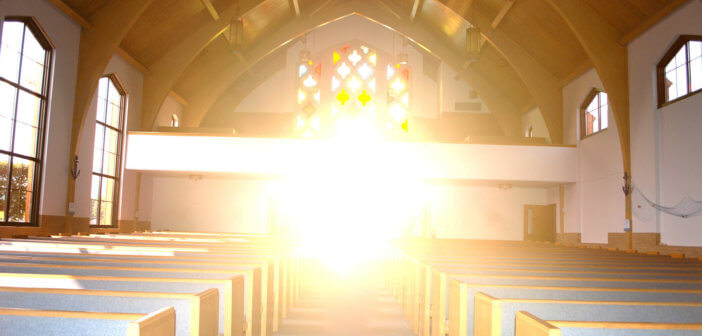Krin Van Tatenhove and Rob Mueller remind us that a congregation’s physical assets are resources to be stewarded to advance the kingdom. They recommend examining building users and partnerships to see how they can help reignite your congregation’s mission.
Every brick, beam, shingle, stained-glass window, and pew of our buildings came into being through the generous, often sacrificial giving of faithful members. Many of them were pioneers in our communities. They participated in the campaigns for these structures with a vision of prosperous ministry for the future. If still alive, they have spent countless hours in the classrooms, fellowship halls, and sanctuaries of these places that are sacred to them. The church is their second home, familiar down to the details of how they have arranged the library or parlor furniture. They have faithfully paid the bills for utilities, repairs, and insurance. In short, the brick and mortar have survived due to their dedication.
Church building belong ultimately to God
We’ve all heard the phrase “familiarity breeds contempt.” When it comes to our church facilities, it is more apt to say, “familiarity breeds an antiquated sense of ownership.” It is far too easy for longtime members to forget an essential theological premise that informs incarnational mission. Ultimately, the church building belongs to God. Not to the entity whose name is on the deed. Not to a mortgage company. Not to the judicatory body. Not to the members themselves, not matter how hard they have worked to maintain it.
Stewarding building assets to advance God’s Kingdom
This structure belongs to our Creator, and we as stewards must maximize the use of every square foot in advancing the kingdom of God. Second only to the gifts of our members, our physical buildings are the greatest asset at our disposal. The critical question to answer is, “How can we integrate out buildings not only to serve God’s purpose now, but as a way of positioning our church for generations to come?”
Raising this question, as many leaders will testify, often results in powerful resistance. Change is hard! That is why we need champions of a different paradigm. As we begin to experience the abundance of gifts present in our congregations and neighborhoods, as we learn to listen before acting, as we forge new partnerships, a miracle unfolds. This is the power of the resurrected Christ in our midst, the promise of abundant life, and it applies to a new sense of stewardship about our building. Rather than focusing on the burden of their upkeep, we focus on our renewed belief that God has fresh purposes we are only beginning to glimpse.
New directions with current partners
If you are already sharing your building with other groups — preschools, AA meetings, nonprofits — the first order of business is to reevaluate the quality of these relationships. Are there meaningful connection points? Is there some kind of cross-fertilization? If not, how can we take steps toward a common sense of mission? Spending time in dialogue and relationship building is key to this new direction. There may be hours of listening necessary to set the groundwork. Start now with this investment of time, believing it will lead to abundance.
New expectations for future partners
If you are considering new partnerships under your roof, make sure that your expectations are clear from the beginning. This is far more than negotiating a joint-use agreement. It means establishing guidelines for mutual investment in each other, a way of communicating our belief that we are always better together. Guard against the false notion that just because our buildings have more activity, we are going to experience resurrection. Far too many churches have found that even with multiple groups under their roofs, they have not seen increased spiritual energy. Always remember that the goal is integration, not just space sharing.
New understanding of place
Every leader and every area of ministry must ask themselves some basic questions: How can we make this place that we love so dearly a powerhouse for mission? How can we consider deployment of our space as part of our plan for the future?
This material is excerpted and condensed from Neighborhood Church: Transforming Your Congregation into a Powerhouse for Mission (Westminster John Knox Press, 2019) by Krin Van Tatenhove and Rob Mueller. Used by permission. The book is available at The PC(USA) Store.






